Soup plates: what sizes are there and how to choose them?
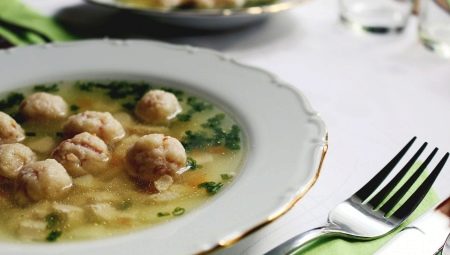
It is difficult to imagine a kitchen or catering establishment without deep soup bowls. Their main purpose is to serve hot and cold soups, dairy dishes, broths, liquid dishes. Despite the rather familiar appearance, soup plates differ in shape, volume and material of manufacture.
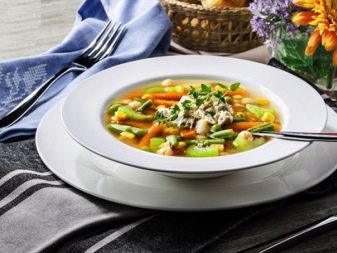

Peculiarities
Deep plates should not have handles (these are tureens or soup bowls). On the table, they are placed on a serving plate, a spoon is placed on the right. Pie is usually placed in front of the soup plate, sour cream and sauces are served in gravy boats.
According to the rules of etiquette, soup is served on the table in a common tureen, and from it the guests are distributed among the plates. At the same time, the sides of the plate must remain perfectly clean.

Materials (edit)
Dinner plates can be made from a variety of materials. It is impossible to single out those that are better or worse. The main thing is to understand in what conditions and for what dishes you plan to buy dishes. Already from these criteria, you can build on when choosing the material of the product. Let's consider the most common options.
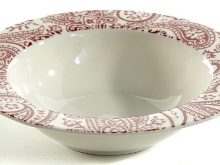
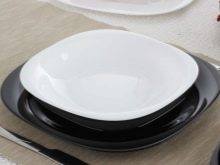
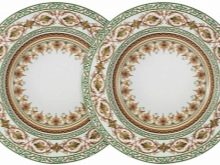
Ceramics
Ceramic tableware is made of natural clay that can withstand high temperatures. The dishes are covered with glaze on top, and when finished, they can have both natural terracotta shades and be painted in any other color. It is also possible to apply painting and drawings to ceramic plates. Such products are quite thick and heavy, but, despite this, fragile: they can crack from impact, from a sharp change in temperature.
However, the plates themselves maintain the temperature well. - the hot broth in them will remain hot for a long time, and the cool okroshka will not heat up.Outwardly, such dishes look laconic and even somewhat rude.
It fits perfectly into the interior of the kitchen in country or retro style. Most products cannot be washed in a "dishwasher".
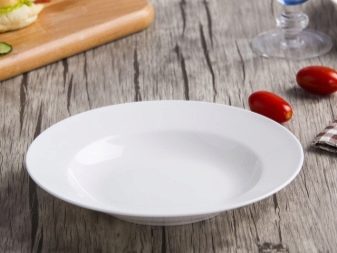
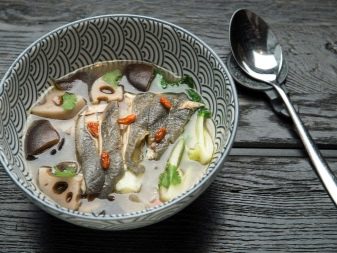
Faience
Faience is the same ceramics, but which has undergone a single firing and is more advanced. The top layer is glaze. Earthenware plates are quite heavy, but porous. The latter property becomes the reason that earthenware dishes are fragile.
However, with enough careful handling, the plates will last long enough. This, as well as affordability, makes these models very popular. It should be noted that over time, scratches and grooves form on the surface of the earthenware. At the site of damage to the upper layer, darkening forms over time.
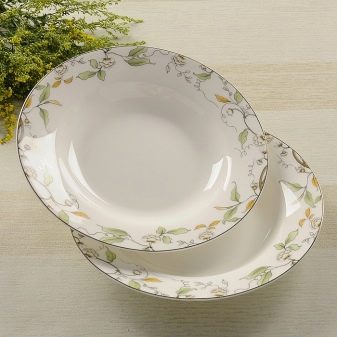
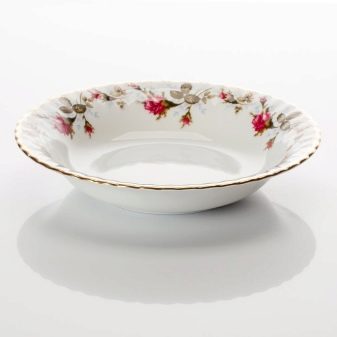
Porcelain
Porcelain is a clay base, but it is subjected to repeated firing. As a result, the product is lightweight, and there are no pores on its surface. As a result, porcelain plates are resistant to acids, alkalis, high temperatures. Food in porcelain dishes stays hot for a long time... The most durable and expensive models are made of hard porcelain. Models of white color with gilding have become classics for a long time. Lovers of minimalism should consider the option of snow-white plates without patterns and reliefs.
Due to its exquisite appearance porcelain always looks festive, such a set is an excellent option for festive feasts. Do not put china dishes in a dishwasher or microwave oven.
It is forbidden to boil porcelain or wash it in excessively hot water; it is better to purchase a special detergent to care for the products.
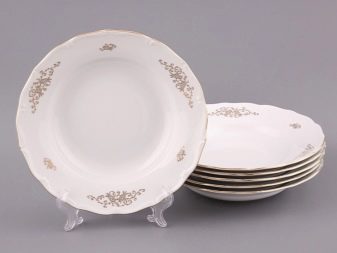
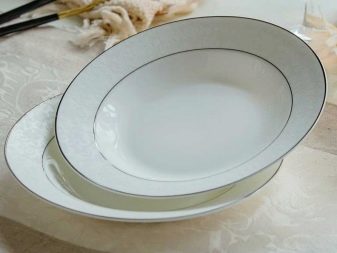
Heat resistant glass
Dishes made of this material can be transparent, darkened and colored, with pictures. It is optimal for use in a microwave oven. The plates are affordable and durable, the main thing is to avoid sudden temperature changes when using plates.
Dishes with many elements look especially impressive in transparent and darkened products. Glass-ceramic counterparts have some similarities with glass plates. However, they are more durable (they are not afraid of light blows) and are less susceptible to temperatures.
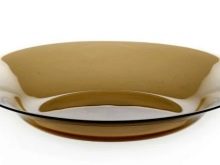

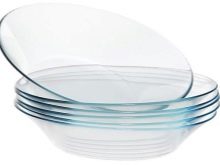
Crystal
Outwardly such plates remind glass, but they are heavier... If you look through the crystal plates, you can see how rays of light play and refract through it. Crystal is rarely used to make soup bowls because it can only be used with cold dishes. If this rule is violated, the material may darken and crack.
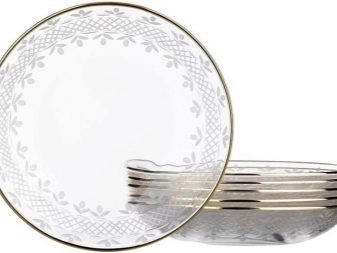
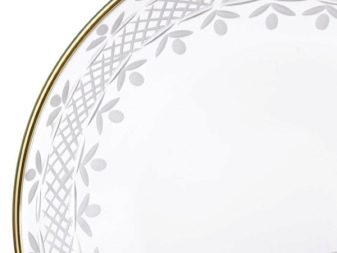
Metal
Metal plates - these are usually aluminum and steel (stainless steel) products. First of all, they are durable, and therefore are considered a traveling option. However, such models quickly heat up, so when using them it is easy to get burned.
Do not use metal microwave ovenware, but can be placed on the grill or gas stove (use a divider).
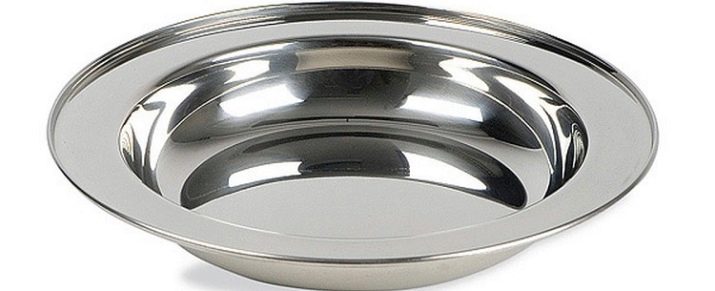
Plastic
The products are not suitable for frequent use. They must be fulfilled. food grade plastic, preference should be given to products made of polystyrene or polypropylene. Make sure that this type of plastic is suitable for hot food before use. Another disadvantage of plastic plates is the food in them cools down quickly, they themselves heat up and are easily deformed.
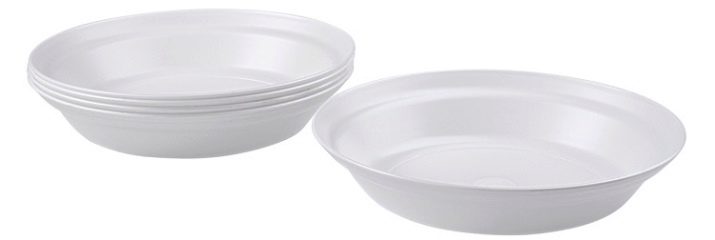
Wood
Wooden plates are, first of all, environmental friendliness and authenticity. However, today they are commonly used as a decorative element. The reason is that such dishes are difficult to care for, in addition, the wood absorbs odors.
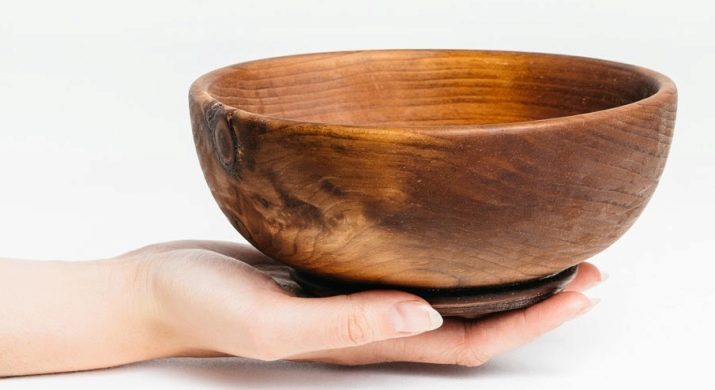
Corian
Modern material obtained through chemical experiments. Represents fake diamond. Products made from it are quite durable, attractive and noble in appearance.
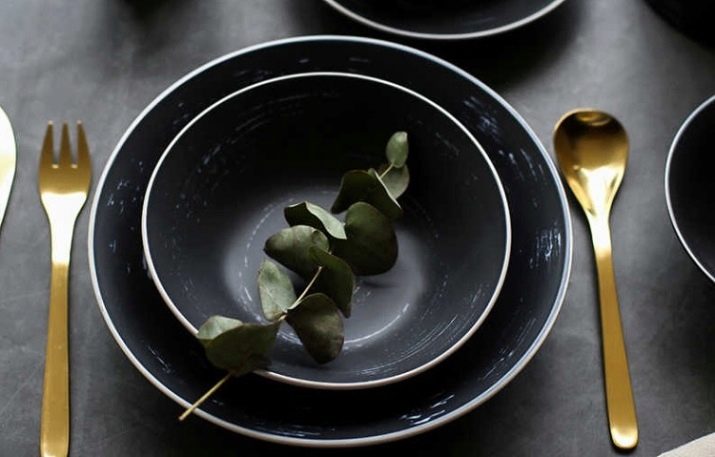
Sizes and shapes
Typical deep dish sizes range from 0.25 to 0.5 milliliters. The diameter of the dishes also varies and can be equal to 20-40 cm. Smaller plates are usually suitable (diameter 23-24 cm, possibly up to 27 cm) for children and the elderly, as well as for those who carefully control the amount of calories eaten. Deep dishes with a volume of half a liter are optimal for men, as well as those who do not limit themselves to food. Thus, the number of grams in one plate depends primarily on its volume. A standard product usually contains 250 ml of soup.
Traditionally, dinner plates are deeply shaped with a bottom diameter that is less than the diameter of the top. Thanks to the beveled edges, broths and soups do not spill out of the dishes, in addition, the sides serve to remove excess liquid from the spoon. The sides of the plates can be smooth or embossed, they are often decorated.
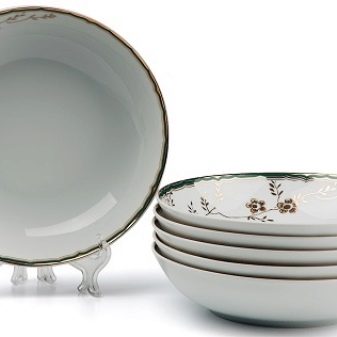
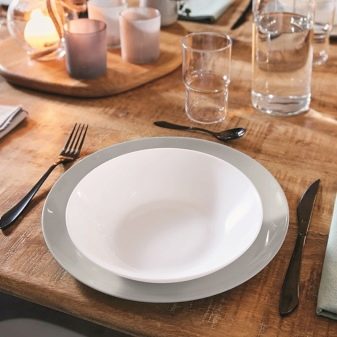
The sides can be wider, sometimes you can even serve sauce on them. It is sometimes difficult to pour soup into bowls with wide rims without staining the rims. In addition, these plates take up a lot of table space when serving. The wider the plate, the faster the soup will cool down, the deeper the bowl the food will stay hot longer. Modern manufacturers also produce crockery with a square and even triangular shape. Square products look stylish, take up little space on the table, and are also ergonomic in storage.
Separately, it is worth highlighting the plates for babies. As a rule, they are deeper and can be equipped with small handles. However, it is recommended that older preschoolers and schoolchildren be taught to eat from "adult" dishes, that is, classic soup plates.
A distinctive feature of children's plates is the design - it is always bright and colorful, repeating plots and pictures from cartoons and books.
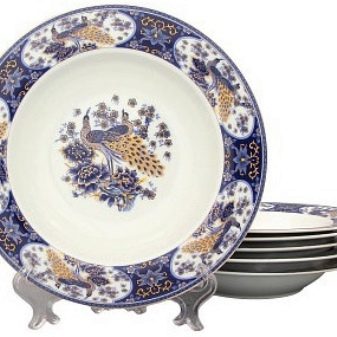
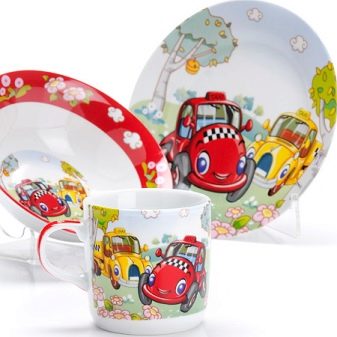
Manufacturers rating
Consider the most popular brands which have deep bowls in their product lines.
- Premium brand Colombo (China) produces serving dishes, as well as porcelain tea sets. A new designer collection is regularly released. All the collections are united by a floral ornament that goes on snow-white dishes. In Russia, it is difficult to purchase the products of this manufacturer, since there are no official stores. However, you can find official distributors on the Internet.
- Another premium brand is the German company Continental. She positions her porcelain products as tableware for establishments, since they have increased strength indicators. For this purpose, the products are composed of aluminum oxide and additionally reinforced edges of the dishes. As a result, it turns out to be inert to temperature extremes, acids, and shocks. Cookware also comes with a 5-year warranty from the date of purchase.
- Tableware for the restaurant is also produced by Helfer (Austria)... These are porcelain pieces with a classic design. A clear advantage is increased impact resistance, stylish elegant design.
- American brand Corelle also gives a guarantee for its cookware (albeit 3 years), which is made of three-layer heat-resistant glass. The products are uncoated or glazed on top of them, which results in an imitation of a porcelain surface. The dishes are suitable for serving and use in microwave ovens, do not absorb odors, keep food warm for a long time. And thanks to the “decal” painting (embossed ornaments that are applied by engraving or perforation), the dishes are especially beautiful, and the drawing lasts up to 10 years with daily use of the dishes.
- If you like high-quality double-fired and glazed ceramics, then take a look at plates Costa Nova. In addition to the high quality and durability, it is worth noting the visual appeal of the dishes. The main design motives are ethnic, floral.
- There are also worthy brands among domestic manufacturers, for example, Domenik. The products are produced in 3 versions - glass, ceramics and porcelain. It is clear that glass plates are suitable for use in microwave ovens, however, this manufacturer makes possible similar use of porcelain counterparts, thanks to a special production technology. As for the design, this is a variety of choices in the main classic direction. There is also a line of children's tableware.
- Perhaps one of the most amazing companies is Leander. They make plates and other utensils from porcelain. It is striking that the products are painted by hand, but at the same time their cost remains quite affordable for the buyer.
- Lovers of glassware can also recommend plates of the brands Luminarc (France) and Pasabahce (Turkey)... The use of high-strength heat-resistant glass avoids the appearance of pores on the surface, and therefore makes the plates durable, inert to the effects of acids, abrasives, and high temperatures. These items are microwave safe and dishwasher safe. Cymbals from Luminarc are a combination of classic performance and practicality.
- Posud de Luxe company will appeal to lovers of unusual shapes and designs. The product line is divided into 2 groups - ceramic and porcelain tableware.
- If you're looking for bold colors and designs, pay attention to GreenGate products... A red plate, black with white patterns - these are far from all possible options.
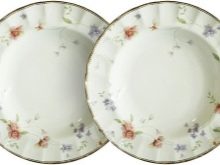
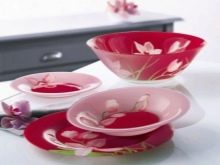
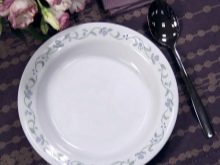
Selection rules
The first criterion when choosing soup bowls is the material of manufacture. For special occasions, as well as, if finances allow, preference can be given to porcelain. If food is often heated in the microwave, then glass products should be chosen. For those who are worried about the environmental friendliness of dishes, we recommend ceramics. A universal and democratic option is faience.
When choosing porcelain, lightly hit it with your hand. Porcelain should sound loud, and the sound will gradually fade away. If you hear a dull sound, this is faience, passed off as more expensive porcelain. Naturally, need to check quality certificates - this is the only way to make sure that the dishes comply with existing standards, their environmental friendliness. The most convenient shape was found to be round.
For celebrations, you can purchase unusual square counterparts, but eating from such a container is inconvenient every day.
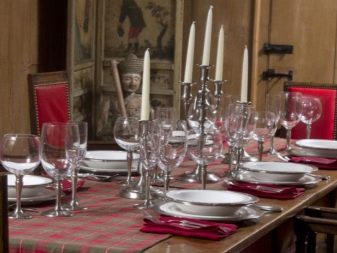
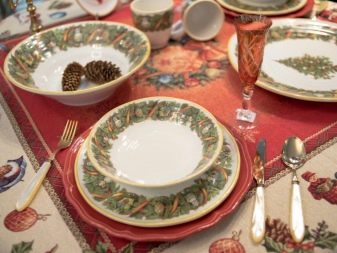
The classic color is white and its shades. Such dishes look organically in any kitchen, combined with a variety of tableware and textiles. Light plates with a vegetable pattern can be considered versatile, they will help create a light and relaxed atmosphere. Psychologists say that the bright colors of the dishes stimulate the appetite.
If you are not afraid to eat too much, then brightly colored dishes will help to place accents at the table. If you feel a lack of energy, it is recommended to use dishes of green, light green shades. Plates of rich yellow and red colors stimulate appetite. Cool blues and deep blues, on the other hand, will help control it.
Embossed items may look more attractive, but care of such items will be more difficult. Food particles can become clogged in grooves and bumps, causing yellow or dark spots to appear.
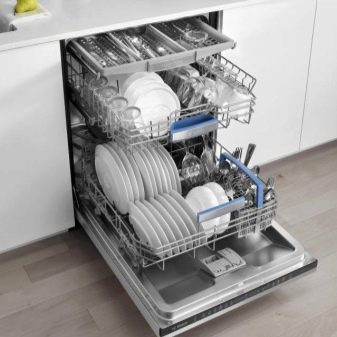
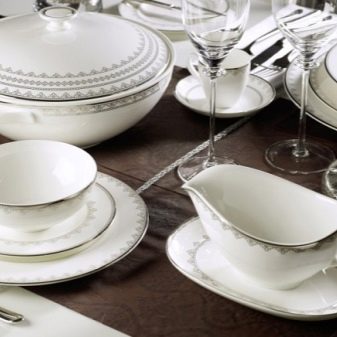
In the next video, you will find an overview of the Luminarc Feston Soup Plate.








